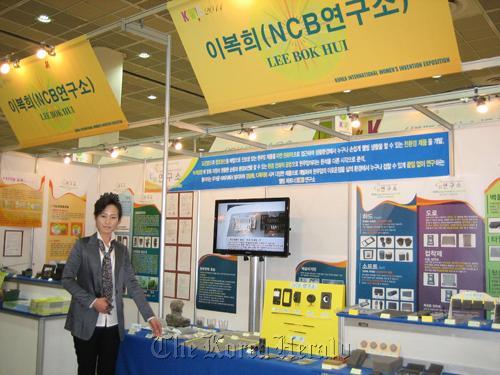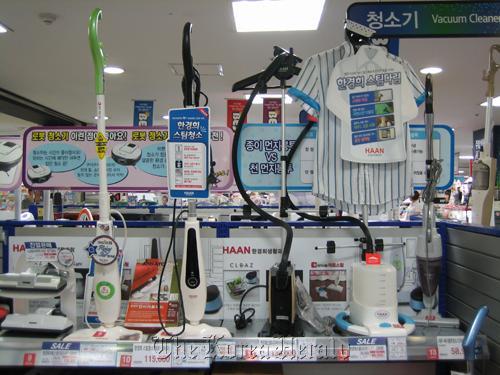Creative housewives discover that they can be successful in the business world
Lee Bok-hui used to wonder what happened to all the leftover stones she saw lying around construction sites. Now she knows exactly where a percentage of those leftovers go ― into an eco-friendly sheeting-material used to reinforce electrical outlets, which she invented specifically to reuse that construction site waste.
Lee debuted her invention at the Korea International Women’s Invention Exposition in May, where she won second place in the expo’s title competition.
“I never could imagine that I would win the prize, but I always stood by my idea and knew it was good for the future,” Lee said in an interview.
 |
Lee Bok-hui shows off the material she invented out of construction waste. (Yonhap News) |
Lee is among the small number of Korean women who are doing something not usual in the male-centric Korean business world ― taking their careers into their own hands through invention. And surprisingly, many of these new inventors are housewives.
South Korea is one of the top 20 richest economies worldwide.
But according to the World Economic Forum’s Gender Gap Index 2010 report, Korea’s gender equality only ranks 104 out of 134 countries surveyed, near the bottom with developing African countries and Middle East states with strict rules governing women’s rights.
In comparison, Iceland ranks No. 1, with the United States at 19 and the Philippines at 9. Korean women fall far behind Korean men in economic participation and pay. This is in stark contrast to the almost equal percentages of women and men getting university degrees.
“The Korean cultural tradition that goes back hundreds, thousands of years, is that women didn’t need to work,” said Paik Seung-han, a senior vice president at SK Networks, a branch of one of the largest Korean conglomerates.
“But over the past 20 years this tradition has gradually changed,” said Paik, whose corporate culture division boasts 30 percent women, many of them in general manager positions.
However, even if women do achieve some success in the business world, it can be difficult to hold on to those roles after they marry and have children because of deeply instilled cultural traditions. This could also account for the rise in the marriage age and lower birthrates in the past decade.
Former corporate recruiter Bailey Park said she knew two high-level female managers in well-known corporations.
“One was a 40-something-year-old single lady and another one was postponing having kids until she reached at least a mid-level position in the company,” Park said.
“The Korean business world is very competitive. There is no 9-to-5, no weekends,” said Paik, conceding that it’s hard for new mothers to keep the grueling work hours.
Because of the strong work ethic and cultural tradition, many career women do leave their jobs after marriage and children. Since Korean women are highly educated, it might not be very fulfilling for them to see their educations go toward homemaking.
Enter the Korean Women’s Inventors Association to lend a guiding hand. The organization has shown housewives that they can still be active in the business world through invention. More than 4,000 women are now members and half of the female patent-holders are housewives, according to KWIA.
Koreans are avid inventors in any case and rank fourth worldwide for registering the largest number of international patent applications, according to the Korean Intellectual Property Office’s latest figures. And although the percentage of females among all patent applicants is only around 13 percent, this number has doubled since 2005.
 |
HAAN Corporation steam cleaners for sale at a Seoul Lotte Mart. (Yonhap News) |
Around 400 inventions by KWIA members have gone on to be commercial successes. The most successful is the floor steam-cleaner thought up by former housewife Han Kyung-hee, who’s also known as Romi Haan. One of The Wall Street Journal’s “Top 50 Women to Watch” in 2008, Han now oversees her products in the HAAN Corporation that also includes vacuum cleaners, garment steamers and irons and nets $100 billion annually, according to company figures.
Other successes include Locksis, a do-it-yourself lock installation system, and Loofen, a food-waste dehydrator that eliminates smells as well as garbage collection fees.
“Through invention, women can now have another option to balancing a family life while still doing something meaningful for their careers,” said KWIA spokesperson Mikael Kim.
But how about women who have families, yet also wish to continue their corporate careers?
“There needs to be a gender mainstreaming work-family balance system, realization of gender-equality policies and cooperation with civil society and government organizations so that a change in societal perception can be induced.” said Han Hee-sook, a professor who heads Sookmyung Women’s University’s Research Institute of Asian Women.
Already, ripples of change are creating positions for women as well as helping them retain their positions in the workforce.
Sookmyung Women’s University started the country’s first female ROTC program last year. Two of the nation’s largest conglomerates, Samsung and SK, have set up day care centers for employees.
But the shift in cultural attitude and desire to have a career has to come from Korean women as well, said Park, the former recruiter.
“The thing is, still there are lots of Korean women who want to meet rich husbands, quit their jobs and are willing to be housewives,” she said.
(Yonhap News)





![[Herald Interview] 'Trump will use tariffs as first line of defense for American manufacturing'](http://res.heraldm.com/phpwas/restmb_idxmake.php?idx=644&simg=/content/image/2024/11/26/20241126050017_0.jpg)

![[Health and care] Getting cancer young: Why cancer isn’t just an older person’s battle](http://res.heraldm.com/phpwas/restmb_idxmake.php?idx=644&simg=/content/image/2024/11/26/20241126050043_0.jpg)

